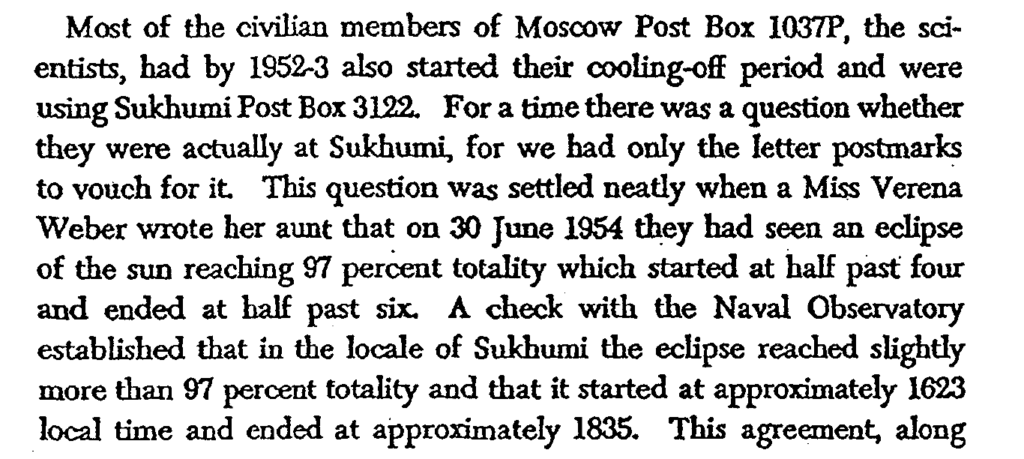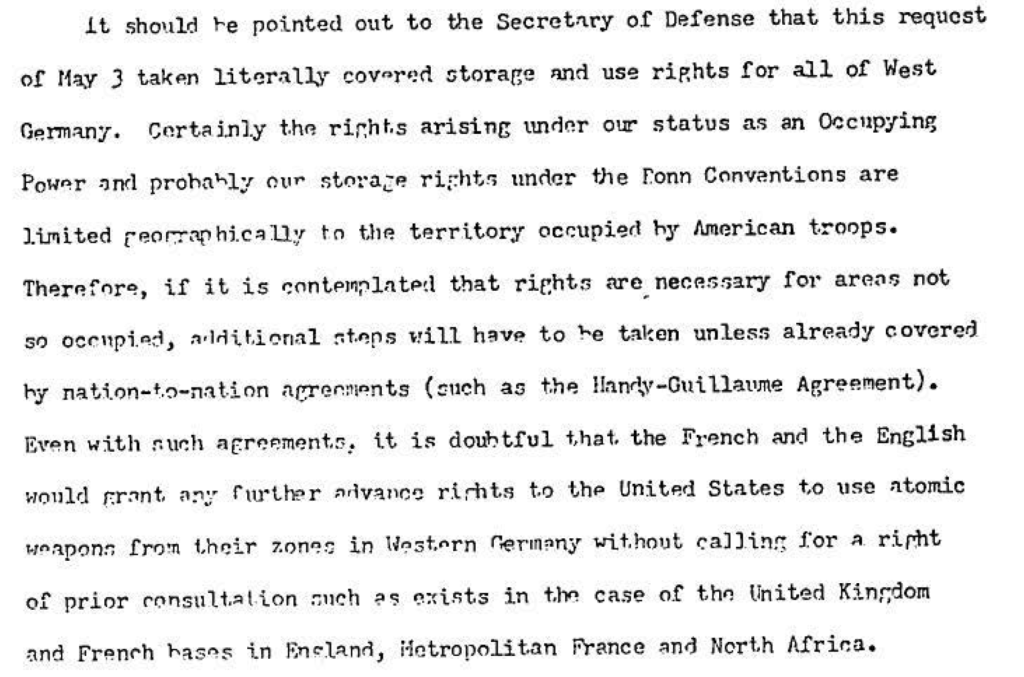I always find it interesting to check what experts thought about proliferation in the past. In 1995, a CFR Task Force issued a report titled Nuclear Proliferation: Confronting the New Challenges. The list of members makes for interesting reading, as do the recommendations.
Category Archives: Uncategorized
Soviet Denial and Deception and Cuban Missiles
Back in 2002, Studies in Intelligence published a piece titled “Soviet Deception in the Cuban Missile Crisis: Learning from the Past.” The article, written by James Hansen, has a great description of Soviet denial and deception efforts surrounding Moscow’s placement of nuclear weapons in Cuba.
Here’s an example:
Developing A Cover Story
The General Staff’s code name for the operation—ANADYR—was designed to mislead Soviets as well as foreigners about the destination of the equipment. Anadyr is the name of a river flowing into the Bering Sea, the capital of the Chukotsky Autonomous District, and a bomber base in that desolate region. Operation ANADYR was designed to suggest to lower-level Soviet commanders—and Western spies—that the action was a strategic exercise in the far north of the USSR. Promoting the illusion, the troops that were called up for the Cuban expedition were told only that they were going to a cold region. Those needing more precise instructions, such as missile engineers, were informed that they would be taking ICBMs to a site on Novaya Zemlya, a large island in the Arctic where nuclear weapons had long been tested.
To strengthen the concealment, many units were outfitted with skis, felt boots, fleece-lined parkas, and other winter equipment. Moreover, perhaps to further backstop the cover plan, Moscow tapped four ground forces regiments from the Leningrad Military District in the north for dispatch to Cuba. The deception was so thorough that it fooled even senior Soviet officers sent to Cuba. One general there asked Gribkov why winter equipment and clothing had been provided. The general admonished him to “think like an adult,” and explained, “It’s called ANADYR for a reason. We could have given away the game if we had put any tropical clothing in your kits.”
Gerald Smith on U.S. Nuclear Weapons in Germany
Sidney Drell and Richard Garwin on Deterrence and Nuclear Use
In this 2006 interview with Francis Slakey and Jennifer Ouellette, Sidney Drell and Richard Garwin, Slakey asked “When nuclear weapons were first developed, under what circumstances would a president authorize the use of those weapons?”
Garwin:
Nuclear weapons were a scarcity. We finished the war with maybe one nuclear weapon in August of 1945 and had relatively few. And, in fact, the people at Los Alamos had very different views, it turns out of the future. Hans Bethe, shortly before he died, commented that “Nobody at Los Alamos believed that there would be thousands or tens of thousands of nuclear weapons.” And yet, I gave a talk in November 2005, parallel to a November 1945 talk by Robert Oppenheimer, who in his speech to the American, to the National Academy and the American Philosophical Society said that, in 1945, “If there were to be a war between two nuclear-armed countries they would be used by the tens of thousands; by the thousands or the tens of thousands.” So, between these two people who were intimately involved in the creation of nuclear weapons, and Hans Bethe throughout his life afterwards, to have such different views is quite striking. But, nuclear weapons belonged to the civilian side, to the Atomic Energy Commission, for a long time before control was transferred in the field to the military, in part as a result or aided by the permissive action links that were then introduced. It’s the president though, in principle, who can release nuclear weapons. However, he can delegate that responsibility and authority to anybody he wants.
Drell:
I would add to that that the additional period right after the war, the great effort was to try and control the spread of nuclear technology and nuclear weapons, and they were certainly under presidential control. But the first envisaged use was to confront the large Soviet army in Europe as NATO was being built. And they were a substitute for large manpower if the Soviets had moved west. But, when thermonuclear weapons increased the destructive potential of these weapons by factors of a thousand beyond Hiroshima and Nagasaki people soon realized that these are weapons of suicide and it was, I think, President Eisenhower who first said, in 1956, that, you know, “Because of their destructiveness war was no longer just exhaustion of the enemy and surrender but it had become destruction of the enemy and suicide.” Those were very close to his exact words. And so the whole policy at that point was to prevent their use. And so, that’s how the deterrent idea, based on mutual assured destruction, grew up, because there was no defense against them and there was absolutely the highest priority to see that they weren’t used, and so the idea of deterrence. Namely, having a capacity to respond to the worst possible attack upon you and destroy the attacker, therefore to convince him he would be committing suicide if he attacked you was the basis for our arsenal.
Garwin:
Yeah. Exactly right. And when Eisenhower came in, though, he regarded nuclear weapons as a “bigger bang for the buck.” And, that was just at the beginning of the era of tactical nuclear weapons, which paradoxically were encouraged by some of our physicist colleagues as a way of reducing the emphasis on bigger and more numerous strategic weapons whose only purpose would be to destroy society. But, in fact no good deed goes unpunished and pretty soon with the proliferation on our side and the Soviet side of tactical nuclear weapons, and the response of the reformation, reformation of the army structure to be less vulnerable to nuclear weaponry, the nuclear weapons used in combat would kill three tanks, five tanks, or whatever. That same nuclear weapon, used against a city could kill hundreds of thousands of people. And so, what we were doing was to proliferate in our two arsenals vast numbers of strategic weapons, only calling them tactical weapons, and those would be very bad if ever used in warfare. There would be no guarantee that if we used our tactical nuclear superiority and stopped Warsaw Pact armies on their march to the West that the Soviets wouldn’t escalate and use nuclear weapons to compel surrender by using them on cities, in fact. And, not only no guarantee; it was to my mind, absolutely certain that they would do that. And so, then there were all kinds of theories of escalation. But, to go back to deterrence, in 1945, especially ‘49 when the Soviets tested their first nuclear weapon, there was panic among the populace and an attempt by a far-sighted people even before that to obtain active defense against the aircraft that would deliver nuclear weapons. And pretty soon it became apparent that we could no effective defense. So, Bernard Brodie and others, strategists, said “Never mind. We can be protected even without defense if we maintain a survivable, commandable nuclear force so that the Soviet nuclear weapons would essentially be turned back upon themselves, that is with high assurance a use of nuclear weapons against the United States by the Soviet Union would result in the destruction of the Soviet Union. So, it was that tenuous, difficult balance, which was not a numerical balance at all, that was responsible for security for so many decades. Now it’s more difficult. If nuclear weapons are obtained by people without home bases or without values it’s hard to deter them when their only purpose may simply be to kill on the other side.
Munir Ahmad Khan on Proliferation
I’ve previously mentioned that a number of PAEC folks made informative statements at the 2007 Memorial Reference for Munir Ahmad Khan. In this case, Former Senator Farhatullah Babar discusses Khan’s expression of concern with respect to proliferation and command and control issues:
In communications with the then Prime Minister Benazir Bhutto and also in newspaper articles Munir Khan pleaded, “nuclear weapons are not a plaything to be bandied publicly. They have to be treated with respect and responsibility. While they can destroy the enemy, their use can also invite self destruction” Babar said that Munir Khan wrote two letters to the Prime Minister in which he pointed towards the potentially damaging consequences for Pakistan in view of irresponsible actions and rhetoric by certain individuals.
Farhatullah Babar said it was a strange coincidence that on his death anniversary today the International Institute of Strategic Studies in London had announced that a new dossier “Nuclear Black Markets: Pakistan” will be launched next week dramatizing the warnings that Munir Khan had been sounding. “We did not heed his warning then and have ended up in making Pakistan a suspect at the centre of international proliferation,” he said.
Bullshit Man
Could be a tiring Job in some locales:
Richard Garwin and Rumsfeld Commission
In this 2004 interview, with Dan Ford from the American Institute of Physics, Wolfgang Panofsky discusses Richard Garwin and his stint with the Rumsfeld Commission:
I think the instance often mentioned, you know, he was a member of the famous Rumsfeld Commission, which was charged with assessing the threat to the United States of ballistic missiles. But to most observers, was simply a… had a not so hidden agenda of justifying ballistic missile defense. Now Garwin basically did an honest job on that committee of basically assessing the North Korean threat and in turn, the fact that he who is usually more identified with the arms control side of things and who was usually very much identified with the loyal opposition to ballistic missile defense, nevertheless found that his concurrence with the findings of the Rumsfeld Commission and the subsequent use of that report to justify BMD.
That is often cited as to some extent being a symptom of naivety on his part on being oblivious to the political implications of his activities while doing an absolutely straightforward honest job on the technological parts of the thing. I mean, that’s one example where he basically proceeded to analyze the explicit task given to that Commission but… And since that Commission was not asked to recommend specific remedies to the ballistic missile threat, but only to analyze the ballistic missile threat, he kept to that. But in fact, the not so hidden agenda of that Commission was to justify BMD, so that’s essensially an instance.
IAEA Safeguards and Intelligence, 1968
On the Soviet Nuclear Scent and Eclipses
Obviously not news, but I do like this excerpt from “On the Soviet Nuclear Scent” by Henry S. Lowenhaupt.


The piece cites a number of cases where American and British intelligence analysts used intercepted letters and other sources to locate various facilities associated with the Soviet nuclear weapons programs. Scholars have written considerably more on this topic since 1967, but I find it interesting to read the conclusions drawn based on the then-available information.




